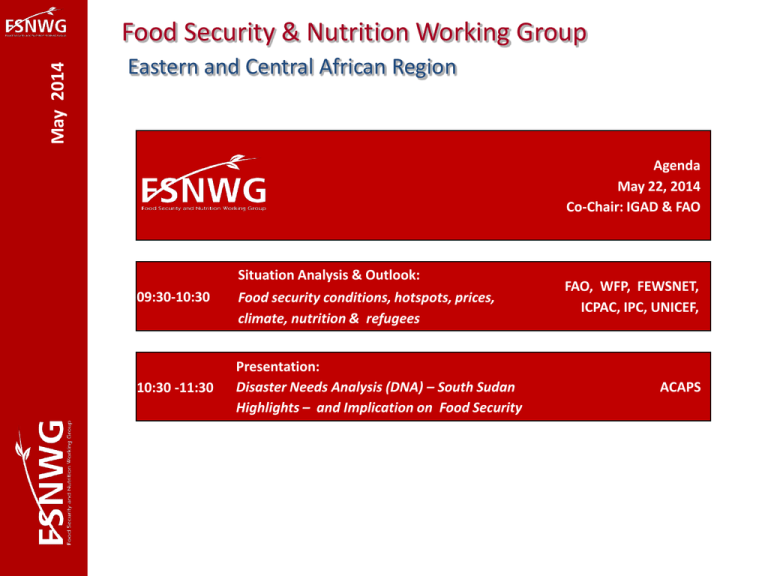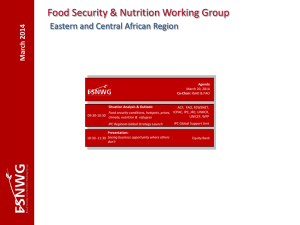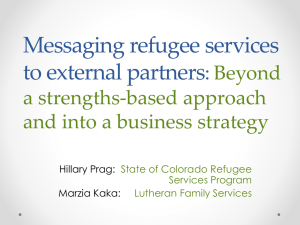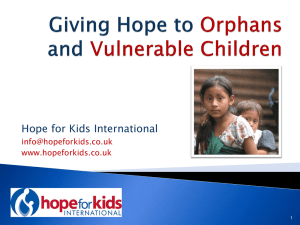Final FSNWG Situation Analysis Outlook May 2014
advertisement

May 2014 Food Security & Nutrition Working Group Eastern and Central African Region Agenda May 22, 2014 Co-Chair: IGAD & FAO Situation Analysis & Outlook: 09:30-10:30 10:30 -11:30 Food security conditions, hotspots, prices, climate, nutrition & refugees Presentation: Disaster Needs Analysis (DNA) – South Sudan Highlights – and Implication on Food Security FAO, WFP, FEWSNET, ICPAC, IPC, UNICEF, ACAPS Regional Highlights May May 2014 2014 Current Conditions: Many regions are in stressed condition and specific areas are under crisis or emergency (CAR/DRC/South Sudan and part of Afar Region of Ethiopia). Some areas are at risk of further deterioration (South Sudan, CAR, Sudan) May May 2014 2014 Current Conditions – Regional Highlights South Sudan IPC report May 2014 More than 3 m people are currently in need of urgent humanitarian response (IPC 3 or higher in Unity, Jonglei and Upper Nile). Large portions of the population in conflict‐affected areas are in IPC 4. Further deterioration and increase in the size of the food‐insecure population are very likely, because of : - impacts of continued conflict and ongoing displacement (over 1m people) - significant numbers of people not able to prepare and plant their land (displaced, limited agricultural inputs prepositioned or made available by traders/agencies,…) - constrained humanitarian access to IDPs (using host communities’s resources) - widespread market destruction/disruption (high dependence from May to August) - traditional lean season and rainy season that further limits access and trade flows - expectations for a poor 2014/2015 cropping season - a sharp reduction in agricultural labor opportunities - limited access to traditional coping strategies (fishing, hunting, wild foods) -(production of crude oil fell by nearly 30 % since the outbreak of the conflict) Risk of famine particularly in Mayendit, Koch, Panyijar, and Leer Counties in Unity State and Ayod, Duk, Uror, and Nyirol counties in Jonglei State. The worst‐off areas of Upper Nile State are Baliet and Panyikang. If the harvest is very poor and conflict continues, food security in 2015 may be as bad or worse than 2014. Without urgent action, famine is possible in localized sub‐county of Jonglei and Unity States during the coming 4 months May May 2014 2014 Current Conditions – Regional Highlights Sudan FEWSNET Avril 2014, OCHA An estimated 4.5 m people face Stressed (IPC Phase 2) or above food insecurity levels. The food insecure population has increased by 38 % since January. Widespread displacement following renewed conflict in Darfur and ongoing conflict in South Kordofan and Blue Nile states combined with reduced food availability after poor harvests has resulted in an early onset of the lean season in April. Food insecurity is expected to deteriorate in many areas of the country. Insecurity and logistical constraints associated with the rainy season will continue to disrupt humanitarian assistance and trade flows to and within South Kordofan, Darfur, and Blue Nile states. IDPs in the SPLM-N-controlled areas of South Kordofan are the most acutely food insecure (IPC Phase 4), namely because of restricted trade flow and lack of access by humanitarian agencies). IDPs in SPLM-N-controlled areas of Blue Nile State, new IDPs in Darfur, returnees/refugees in Abeyi, and South Sudanese refugees in White Nile, South Kordofan and West Kordofan states face Crisis (IPC Phase 3). The size of the food insecure pop. is expected to peak at nearly 5 m people in June 2014, concentrated in Darfur, South Kordofan, Blue Nile, Red Sea, Kassala, North Kordofan and White Nile States. Conflict has disrupted financial systems and trade, the provision of health services and interrupted seasonal livelihood activities in Darfur. Influx of refugees from South Sudan to Sudan continues. Currently, there are 31,000 refugees in White Nile State, 15,000 in Khartoum, and about 12,500 in South Kordofan. Food insecurity worsens with record-high cereal prices and intensified conflict that is likely to continue (Tribal clashes and between SAF and SPLM-N) May May 2014 2014 Current Conditions – Regional Highlights Somalia FSNAU, FEWSNET Federal Government of Somalia troops, supported by the AMISOM, have been advancing into Al Shabaab-controlled areas around several major towns and villages in South-Central Somalia (Bakool, Hiraan, Gedo, Bay, and Lower Shabelle Regions) since February. Access to humanitarian interventions will likely be reduced from current levels due to increased civil insecurity in most rural areas of the South. Recently intensified conflict in the Shabelle Valley will likely result in reduced availability of agricultural labor opportunities followed by a below average Gu harvest in June/July. Food security is likely to deteriorate, reaching Crisis (IPC Phase 3) from July to September 2014. Outside of Lower and Middle Shabelle, pastoral and agropastoral areas in the South are likely to remain Stressed (IPC Phase 2). 857,000 people were projected to remain acutely food insecure through June 2014 by FSNAU, FEWS NET and partners in January 2014. Between January and March during the Jilaal dry season, the high temperatures resulted in water scarcity in some areas. Water trucking continued into April, much later than usual. Pasture conditions deteriorated. In the North, water trucking was on-going through March in most pastoral areas. Despite water shortages, rangeland conditions remain adequate. In the central regions, poor pasture and water availability were observed in the pastoral and agropastoral livelihood zones. Food security is deteriorating in the South due to intensified conflict May May 2014 2014 Current Conditions – Regional Highlights CAR IPC May 2014, FAO Insecurity and tensions exacerbate food insecurity particularly in the N-W Region of the Country (IPC Phase 4). Country facing acute and complex emergency esp. in conflict affected areas. Performance of most economic sectors have declined since 2012 with implications on income generation. Food security situation has deteriorated with the beginning of the lean season. 1.7M are in humanitarian phases (3&4), they were 900 000 in those phases in November 2013 the number of people acutely food insecure has likely sharply increased. Access to food is curtailed by widespread displacement, depletion of HH food stocks, destruction of livelihoods & loss of productive assets, inability to raise income, rising food prices, market disruption or limited access to markets. May May 2014 2014 Current Conditions – Regional Highlights Uganda IPC April 2014, FEWSNET, FAO Below-average rainfall since March has exacerbated dry conditions across the eastern part of the country. The lean season started early in February instead of March in the unimodal region of Karamoja that will remain Stressed (IPC Phase 2!). While the onset of rains was timely, they continued with below average cumulative rainfall. Substantive rainfall deficits are developing in the northeastern districts of Karamoja. A reduction in trade volume exported to South Sudan due to the conflict has moderated supply shortfall. Over 96,000 South Sudan refugees have arrived into Northern Ugandan districts of Arua, Adjumani and Kiryandongo since start of the conflict (critical levels of GAM among refugees). Areas of concern : 1.Central Sorghum and Livestock livelihood zone in Karamoja (estimated pop. of 824,104 persons). 2. Western mixed crop farming livelihood zone in Karamoja (estimated pop. of 268,520 persons). Karamoja food security further deteriorates as the lean season started earlier following below average harvest from the last season. May May 2014 2014 Current Conditions – Regional Highlights Djibouti FAO, IPC May 2014 Food security situation under crisis level (IPC Phase 3) in pastoral livelihood zone. IPC Phase 4 in the N E part of the Country where poor food consumption score is more that 80% and livestock is continue to decrease since 5 years Reduced rations for severely food insecure HHs since September 2013; effects of below average Heys / Dadaa (Oct to Feb) rains; Worsening livestock body condition and declining availability of wild foods. Emergency situation in North – East of the Country May May 2014 2014 Current Conditions – Regional Highlights Kenya KFSSG, FEWSNET, WFP Due to the below average and erratic performance of the long rains thus far, household food availability and access will slightly improve through June, but it will deteriorate between July and September, driven by increases in food prices during the August to October lean season. According to the KFSSG, the number of acutely food insecure people increased from 0.8 million in August 2013 to 1.3 million for the next six months ending. Over the same period, the number of acutely food insecure people increased threefold in agropastoral areas including in Baringo, West Pokot, and Laikipia Counties. These areas depend on rainfed agricultural production, and they had a much smaller harvest than normal. The most severe acute food insecurity was found in the pastoral areas in the Northwest, in central parts of Turkana, and parts of Marsabit County, which were in Crisis a month ago The amount of rainfall received so far was below average and poorly distributed over space and time in Isiolo, Wajir, Mandera, and Tana River Counties. Recovery of pasture and browse is still slower, and in some pockets, water points have not been adequately recharged. About 1.3 million people remain acutely food insecure in the southeastern, pastoral and coastal marginal agricultural areas. May May 2014 2014 Current Conditions – Regional Highlights Rwanda FEWSNET April 2014 The long rainy (March-April-May) season started normally in early March, but poorly-distributed seasonal rainfall since mid-March has led to deteriorating ground conditions in southern and eastern parts of the country, threatening crop development. Normal Season B harvests in June/July. The Eastern Congo-Nile Highland Subsistance Farming and the Eastern Semi Arid and Eastern Agro-pastoral zones : 50 % belowaverage season A harvests for maize and beans in January/February. In order to cope, poor households in these areas will engage in irreversible coping strategies and face Stressed (IPC Phase 2) food insecurity until the next harvests in June. Food prices are atypically high during the current lean season, up 30 to 60 percent against the two-year average. Household food stocks: Poor households across the country experienced below-normal Season A harvests during December to February, which did not replenish food stocks to normal levels. Stressed food security outcomes during the peak of the lean season. May May 2014 2014 Current Conditions – Regional Highlights Burundi IPC May 2014 From now through June, households in most livelihood zones will experience stressed food security except the Plateaux Humides and Depression de l’Est zones which are currently in crisis (IPC Phase 3) food insecurity until Season B harvests in June. Poor rainfall in the Dépression de l’Est zone caused Season A production shortfalls which chronic and structural of high density population are limiting food access in the Plateaux Humides zone. As a result of more than 30 percent production deficit in this area, households are unable to meet food needs from their own stocks. Season B 2014 planting is nearly complete. Current rainfall ranges between 10 and 25 percent above-average levels. Normal Season B harvests are expected in June. Tensions over 2015 election preparations continued. Risk of reviving ethnic demons. May May 2014 2014 Current Conditions – Regional Highlights Tanzania FEWSNET The lean season has ended in the southern, central, and western unimodal areas following green harvests in March/April. Households continue to release stocks from the 2013 production season, making maize, beans, rice, and sorghum available on the market. Green harvests of maize, beans, and banana, and sweet and Irish potatoes are abundantly available in markets, serving as substitutes for maize and other grains and effectively helping drive down grain prices. Ongoing rainfall in both bimodal and unimodal areas is providing adequate moisture for pasture regeneration and grazing and has recharged water points for livestock. Milk for consumption and sales is adequately available to households, and livestock migration is declining as the needed resources are becoming locally available in many areas. Food security outcomes would change significantly if the Masika rain stops in the bimodal areas before the crops reach maturity, resulting in decreased availability of labor opportunities and a reduced volume of the harvest. Stable food prices across the Country ensure food access for poor households. May May 2014 2014 Current Conditions – Regional Highlights Ethiopia FEWSNET Due to the below average October 2013 to January 2014 Meher harvest, poor and very poor households will exhaust their stocks earlier than normal along the Tekeze River in Amhara and Tigray Regions, in eastern parts of Tigray Region, and in the lowlands in East and West Hararghe Zone in Oromia Region. Therefore, poor and very poor households will be in Crisis (IPC Phase 3) from April to June. Belg-producing areas in North and South Wollo Zones in eastern Amhara Region: Poor and very poor households will be in Crisis (IPC Phase 3) through June 2014. IPC Phase 4 in the Northern part of Afar. Continued influx of South Sudanese refugees particularly in Gambella. May May 2014 2014 Current Conditions – Regional Highlights DRC FEWSNET, IPC, FAO •Prices of staples were stable or lower in February than in January. •Conflict and displacement along the border with CAR, and armed groups in the Kivu region continue to be of concern & cause of food insecurity •Chronic food insecurity in some provinces in the west •Poor & borderline consumption common among rural communities •Food production in 2013 was at average levels •# of people in acute food insecurity and livelihood crisis (IPC phase 3 & 4) estimated at 6.7M (Dec 2013) •Nutrition crisis in the west in Mitwaba: lives characterized by food distress (90.7% of households affected by food insecurity) and a nutritional emergency (21.6% of children 6 to 59 months prevalence of global acute malnutrition) Conflicts a major driver of food insecurity in the country. EASTERN AFRICA RAINFALL ANALYSIS - February to April 2014 May 2014 Outlook March 2014 Across the region, the March rainfall pattern was mostly favourable with markedly above average rainfall in the eastern half of Kenya, most of Ethiopia and South Sudan and southern Somalia. In contrast, Somalia and SE Ethiopia, in contrast, had a mostly drier than average March, though deficits at this time of the season are of no great significance. Western Kenya and parts of eastern Uganda also had a less favourable situation, but with fairly moderate rainfall deficits. Map shows total March 2014 rainfall as a percentage of the 20 year average. March is the month when the “long rains” season broadly starts across East Africa; the single rainfall season in South Sudan and Ethiopia (Meher) also start from March onwards. NOTE: since March rainfall on average is low, the percent of average can reach very high values – this does not imply heavy rainfall amounts EASTERN AFRICA RAINFALL ANALYSIS - February to April 2014 May 2014 Outlook April 2014 The rainfall pattern in April was in marked contrast with that of March. Pronounced rainfall deficits are noticeable, extending from Uganda to NE Somalia, across western Kenya and SE Ethiopia. Worst affected areas are in western Kenya (where some areas are as low as 30% of average), Karamoja and parts of Southern Ethiopia. Eastern Equatoria state in South Sudan is also part of this rainfall deficit pattern. Somalia (except the south) and SE Ethiopia have been under continuing rainfall deficit since March. The rest of South Sudan and NW Ethiopia in contrast have been enjoying consistently above average rainfall, leading to an early start to the growing season. Map shows total April 2014 rainfall as a percentage of the 20 year average. April is the month with the largest contribution to the “long rains” season (Kenya, Somalia, parts of Uganda and SE Ethiopia) In South Sudan (except for the easternmost areas) and western Ethiopia, it is the month when the rainfall season (taking place within March to November) becomes better established EASTERN AFRICA RAINFALL ANALYSIS - February to April 2014 May 2014 Outlook Impacts South Sudan and NW Ethiopia: these regions should be enjoying an early start to the agricultural season, with land preparation and sowing ahead of normal. Obviously, in conflict areas of SSD, ability of farmers to benefit from the early rainfall may be more limited; elsewhere, perspectives are so far fairly favourable, less so in Eastern Equatoria (but it’s early days here). Impacts in agricultural areas of eastern Uganda and western Kenya should have been felt – where planting had not yet taking place, delays will be inevitable. Considering the March rainfall pattern, it is likely that early planting might have taken place in which case the strength of the impacts will depend on the development stage of the crop – seedling stage might require replanting. Pastoral areas in Turkana and Karamoja may be facing reduced pasture and water resources. This will also be the case in SE Ethiopia and Somalia (away from the south) – here, where crops are grown, significant delays in agricultural activities can be expected. A lot will depend on how the rainfall evolves during May. Continuation of the drier than average pattern will magnify the current impacts to far more serious levels. On going monitoring is required and is in place. May 2014 Outlook 7) Expected seasonality over complete time series A phenological analysis for East Africa May 2014 Outlook 6b) Average seasonality of the NDVI A phenological analysis for East Africa May 2014 Outlook 6b) Average seasonality of the NDVI A phenological analysis for East Africa EASTERN AFRICA RAINFALL ANALYSIS - February to April 2014 Outlook May 2014 Onset of Growing Season 2014 Due to the favourable March rainfall, a pattern of widespread early starts to the growing season is noticeable. This strengthens the view that early planting has probably taken place across wide areas of Kenya, SSD, SW Somalia and NW Ethiopia. Where April rainfall was below average, early crop development will suffer to a degree that varies with the exact stage crops are in. Map shows the difference between the 2014 date of onset of the growing season and the average date over 20yrs. Onset of growing season takes place when favourable moisture conditions for early crop growth are in place; these happen when two consecutive 10 day periods with 20mm rainfall or more are verified. Delayed starts to the season can be seen in central and northern Somalia, Djibouti and easternmost Ethiopia, where a growing season has not yet been detected in accordance with persistence drier than average conditions evidenced in the maps above. Delayed start is also noticeable in SW Uganda May 2014 Refugees ‘ May 2014 Refugees Refugee Population Contingency Planning Figures (covering the time period from 1 May 2014 to 31 December 2014) South Sudanese Refugees Refugee Receiving Countries Ethiopia Kenya Sudan Uganda Regional Total Pre-2006 registered refugee population Current Refugee Population as of 25 April 2014 Contingency Scenario – Additional Arrivals (May – Dec 2014) Total Refugee Population by 31 Dec 2014 most likely / worst case most likely / worst case 120,000 3,000,000 95,000 35,000 65,000 205,000 / 255,000 65,000 / 115,000 100,000 / 150,000 300,000 / 350,000 100,000 / 150,000 165,000 / 215,000 240,000 101,000 199,000 / 349,000 300,000 / 450,000 3,810,000 296,000 569,000 / 869,000 865,000 / 1,165,000 450,000 May 2014 Refugees May 2014 Refugees South Sudan Emergency Situation. Process • UNHCR held consultative inter-agency meetings with partners and donors from both the region and the specific countries affected (South Sudan, Kenya, Uganda, Ethiopia, Sudan) on 29-30 April in Nairobi - chaired by UNHCR’s Regional Refugee Coordinator for the South Sudan crisis • A Consolidated Regional Refugee Contingency Plan was developed and presented at the Oslo Pledging conference on 20th May • With funds forthcoming, there are key urgent needs in each country to ensure minimum standards are met. Key messages • Despite the signing of the Peace Agreement, the refugee situation is most likely to continue through the year with returns unlikely. Even in the context of a cessation of hostilities, the food security situation coupled with deep rifts between communities will limit return. • Approaching rains are going to limit access, increase logistic costs and have a negative impact on health, nutrition and WASH • The current funding needs are substantial close to $480 Million for the refugee response and an additional $2 Billion for the response inside South Sudan. Both tracks are essential. Both tracks will save lives and support the people of South Sudan. Nutrition and Food security issues. Refugees May 2014 South Sudan(237,218 refugees as of 9th May). • WFP managed to distribute 10 days food ration in the first May distribution cycle and are hoping for an additional 5 days through air drops bringing total food distributed to 15 days for this cycle. This represents the third consecutive month is inadequate food distribution in these camps and the food security situation is deteriorating rapidly. • • • • • • General nutrition situation has worsened in refugee camps due to food shortages. Protection – rising tensions in Maban refugee camp WASH – difficulty to transport and secure fuel for generators for water pumps Food/Nutrition – Upper Nile food assistance crisis. Air movements essential. Shelter/Settlement & NFIs – Pre-positioning for rains hampered. Health – Increase in malaria and AWD during wet season Nutrition rates in Dolo camp MARCH Months 18.1 FEBRUARY 12.8 0 5 10 15 20 proxy GAM rates(%) Etel Fagbohoun, a UNHCR nutrition officer, checks the condition of Ransom. The food shortages are affecting the health of the little boy and other children Nutrition and Food security issues. May 2014 Refugees Ethiopia (120,946 refugees as of 9th May). • Last week, more than 20,000 new arrivals from South Sudan arrived in Burubiey entry point, Gambella escaping the fighting in Nasir. • Vast majority of new arrivals are women and children(over 70%) although increasing number of men are now arriving. • Refugees report that others are on the way, with more amassed on South Sudanese side waiting to cross the river. • Agreement and Identification, underway on an appropriate land for refugee settlement. • The refugee camps are experiencing high malnutrition rates. There is a lack of CSB+ in the food basket. • MUAC screening for all newly arrived children under 5 years. Uganda(104,635 refugees as of 9th May). • Current pipeline is good but the malnutrition rates are still high. • WFP serves two-three hot meals daily at reception centers. • New arrivals are given monthly food entitlements on relocation. • Agreements and identification of suitable land for refugee settlement is on-going. May 2014 Refugees Nutrition and food security issues. Sudan (79,753 refugees as of 9th May). • WFP has distributed food to 43,937 South Sudanese new arrivals to date. • The malnutrition rates are still high, UNHCR is advocating for nutrition screening on arrival with MUAC included on registration forms • Current sites are in the flood plains and there is a need to urgently relocate refugees to less flood prone areas. Two additional sites have been identified but the relocation is not yet underway. Kenya (35,850 refugees as of 9th May) • Protection – high number of UAM arriving in Kenya, slow registration process • WASH – long process to obtain drilling permits means reliance on water trucking • Food/Nutrition – High rates of GAM, disrupted care practices • Shelter/Settlement & NFIs - Identifying suitable land for refugee settlement • Health – No new measles case reported since 28 April Priority: Identifying and agreeing on suitable land for refugee settlement. Nutrition May 2014 Nutrition Somalia (FSNAU MARCH-APRIL 2014) • Kenya: (NIWG- May 2014) • • Baringo County: overall nutrition situation is Poor and deteriorating mainly in East Pokot; • Nutrition situation in the Pastoral, Agropastoral and Marginal Mixed Farming livelihood zones is classified as Serious Several surveys being conducted this month Jan-Mar 2014 reports suggest very critical prev of acute malnutrition in South central regions, • Southern regions- areas classified as c and serious. Health facilities data sugg increasing trends of GAM in pastoral • Northern and central regions – A stab nutrition situation in most of North ea and central; The situation was project remain stable for the months of Febru April 2014, with exception of North w pastoral where GAM is >15%. And deterioration is expected. • Good access and sustained consumption of milk in NW r may have contributed to sta nutrition situation • Measles outbreak in Puntland have b increasing . • Sustained serious levels of acute maln in Juba pastoralists and agrocpastora since Deyr 2012/13 • Monitoring is continuing for Urban, ID rural areas. May 2014 May 2014 May 2014 Response Analysis Regional Seasonal Calendar Note: This calendar is for illustrations only as it is not yet updated to reflect current changes Source: http://www.disasterriskreduction.net/east-central-africa/fsnwg May 2014 Implications of late rains & response considerations Implications of late rains • Crops fail • Too late to replant • Lack of inputs (seeds for next planting season) • Water & pasture recovery? • Shortfall in household stocks & regional food availability • Price hikes in staple cereals Response considerations • Scaling up of safety net • Input vouchers • Market support • WASH support – monitoring of water points during the next dry season • Feed supplements for dry season 20142014 MayMay 5 Steps used for Response Analysis linked to IPC analysis 1. Understanding main issues driving FS outcomes (limiting factors products) 2. Understand direct and underlying causes of each issue and trends (outcome evidence & contributing factors) 3. Options for solving the identified problem – Gaps, Opportunities & Strategies 4. Prioritization of options (gaps identified for solving food security issues) 5. Implementation of response options, coordination and responsibilities 20142014 MayMay Step 1 & 2 – main issues & underlying causes 20142014 MayMay Step 5 - Options & Implementation Food security issue : Limited knowledge on nutrition Community barriers and Main causes of the problem : Low education levels, poor extension services, Response option : Increase community awareness on nutrition through training and sensitization Support diversification of food production and consumption Key activities /strategies and timing Existing opportunities/potential By Who Short term (Within 1 year) & Medium time (2- 5 years) 1. Continue with on-going training in vegetable production through APFS and other projects 2. Continued therapeutic feeding programmes at health centres by WFP/UNICEF 3. Training for newly recruited health workers on basic Integrated management of Acute Malnutrition and infant and young child feeding (LG/UNICEF) 4. Integrating new born care and infant and young child services into EMTCT programmes (GoU/UNICEF, Baylor College of Medicine) Continue with behavioural change communication social mobilization and advocacy (LG/UNICEF) 5. Training for newly recruited Health workers on basic Integrated management of Acute Malnutrition and infant and young child feeding (LG/UNICEF) 6. Integrating new born care and infant and young child services into EMTCT programmes (LG-UNICEF/Bailor Collage of Medicine) Mobilised communities LG, FAO, Peace & business interaction UNICEF with other areas outside and partners Karamoja High production potential for crops and livestock in the region (crop and pasture land) Available stores to demonstrate proper storage and food utilization Local radios Availability of VHT programmes Availability of on-going nutrition programmes in the region Long term (5 – 10 years) 1. Continue with behavioural change communication social mobilization and advocacy (LG/UNICEF) Availability of VHT programmes Availability of on-going nutrition programmes in the region LG, UNICEF and partners Coordination institution Kotido DLG Kotido DLG May 2014 Food Security analysis in South Sudan Disaster Needs Analysis published on 05th of May by ACAPS May 2014 Introduction Violence broke out in Juba on 15 December between Government and opposition forces At 25th of April, more than 1.2 million people had been displaced by the hostilities. 293 000 refugees and 923 000 IDPs (70% in Jonglei, Upper Nile, Unity) • Humanitarian access is challenging due to security situation and logistical constraints • Protection of civilian is a major concern with the persistent violence and ethnically targeted attacks. May 2014 Key findings Violence has been most severe in Jonglei, Upper Nile and Unity States Over 3,7 million people are at immediate risk of food insecurity, and more than 90% of them are in states that are worst affected by the crisis. Up to 7 million people are at risk of food Jonglei, Unity and Upper Nile have the highest levels of acute and emergency food insecurity (around 2,503 million people) Food-insecurity of residents has also increased Land preparation and planting normally start between mid-April and late June. Due to the lack of seeds, continued conflict and displacement, land preparation will be affected. May 2014 Key findings Most of the supply routes to Jonglei, Upper Nile and Unity are closed, worsening the already existing cereal deficit from own production. Disrupted markets cause problems in food availability for market dependant states as during the hunger gap (May-August) markets are the main source of staple food. Recurring floods will potentially affect a large number of IDPs and residents in Northern Bahr el Ghazal, Lakes, Warrap, Unity, Jonglei and Upper Nile. The violence and potential flooding forces livestock owners to follow non-traditional routes May 2014 Pre crisis food security situation Food insecurity levels usually have peaked in June (during the hunger gap) and reduced around the harvest period (October). In June 2013, 8% and 34% of households were severely and moderately food insecure It is an overall improvement compared to the same period in 2012 but imply that most South Sudanese were still vulnerable in case of a minor shock. In June 2013, Analysis by residential status indicated that • 36% of IDPs were food insecure • 29% for returnees • 8% for residents May 2014 Pre crisis food security situation In October 2013, just over 33% of the population was considered to be moderately to severely food insecure. But major disparities across States: • Western Bahr el Ghazal (52%), • Eastern Equatoria (50%) • Jonglei (37%) Except Unity, the number of severe food insecurity declined compare to June 2013 and the previous seasons. Prior to the start of the conflict, WFP had already planned to assist beneficiaries particularly in Upper Nile, Jonglei, Warrap and Unity States May 2014 Conflict impact on food security In January 2014, the number of people in acute food insecurity and livelihood crisis (IPC phases 3, “Crisis” and 4, “Humanitarian Emergency”) was estimated at about 3.7 million (one million pre crisis) May 2014 Conflict impact on food security May 2014 Conflict impact on food security In June 2013, IDPs suffered significantly from higher levels of food insecurity than residents. In February 2014, although residents had a smaller proportion of severe food insecurity than IDPs, levels of moderate food insecurity were similar Residence status % Severe food insecure % Moderate food insecure IDPs 18% 37% Residents 12% 36% Returnees 19% 52% May 2014 Conflict impact on food security IDPs without access to assistance were expected to continue facing Crisis food insecurity (IPC Phase 3) in coming months with the onset of the lean season in May. The number of people in Humanitarian Emergency (IPC Phase 4) is expected to increase in some isolated counties of Jonglei, Unity and Upper Nile State. The situation could deteriorate in the coming months up to IPC phase 5 in some counties of Jonglei and Unity states. May 2014 Impact on food stock The conflict started at the end of the main cropping season, but: • Several reports mentioned large losses of household stocks in Jonglei, Unity and Upper Nile. • Large stocks in urban or peri-urban areas are highly likely to have been looted or destroyed. • Projections for 2014 indicated that Unity, Jonglei and Upper Nile States would already have the largest projected cereal deficit (62% to 71%) May 2014 Impact on the next season It is expected that the conflict will affect the May-June cultivation season, particularly in Jonglei, Unity and Upper Nile States. Households in these areas are likely to miss cultivation of shortmaturing sorghum and maize May 2014 Impact on Livelihood Usual livelihood of poor household during the lean season are very limited due to the insecurity (collection and sale of grass, firewood and charcoal and migration to urban areas ). The loss of livelihood assets for displaced populations greatly reduces households’ ability to meet food needs during the lean season. Fishing, hunting and wild food collection—activities that typically help households get through the lean season—will remain limited as long as insecurity persists. There are also reports of livestock herds being dislocated from traditional migration routes May 2014 Market and trade route Reliance on markets for staple food supply (sorghum, maize, pulses) by South Sudan rural households is very high. Since 2011, households have considered increases in food prices as more important than all other shocks across all States. As of March 2014, in Lankien, Nyirol County (Jonglei), the price of a 50-kilogramme bag of sorghum had increased by 150% compared to December 2013, from SSP 200 to SSP 500 in March. Fighting continues to disrupt key trade and transportation routes between Renk and Malakal, Juba and Bor and Rumbek and Bentiu. May 2014 Potential impact of flood An average of 340 000 flood affected people in 2012 and 2013 May 2014 Full report available on www.acaps.org Contact in Nairobi: bm@acaps.org







